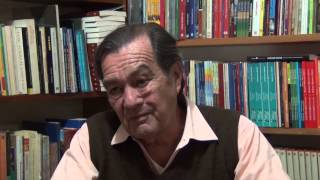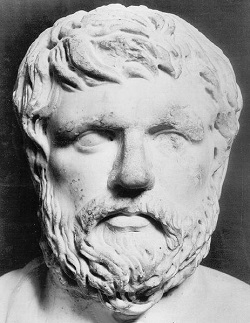|
TRANSLATE THIS ARTICLE
Integral World: Exploring Theories of Everything
An independent forum for a critical discussion of the integral philosophy of Ken Wilber
 Giorgio Piacenza is a sociologist student in the Certificate program leading to a Master's degree in Integral Theory at JFK University. Giorgio Piacenza is a sociologist student in the Certificate program leading to a Master's degree in Integral Theory at JFK University.SEE MORE ESSAYS WRITTEN BY GIORGIO PIACENZA Ancient Greek & Andean Ideas Can still be “Integral” and Useful TodayGiorgio Piacenza
What I'm trying to say that considering the world and everything in it "alive" is not necessarily "magical thinking" from a pre-modern stage.
What I’m trying to say that considering the world and everything in it “alive” is not necessarily “magical thinking” from a pre-modern stage. It can also be an integral understanding that has to come back after modernity’s materialist-reductionist debacle. I would consider an idea “integral” if it is permanent and lasts through approximate stages of cultural development and if it can be used to accommodate include the truths of various stages overcoming apparent irreconcilable need to divide ideas (as in mind-body). Some ancient seminal ideas from previous Earth-respecting traditions—in spite of originating in largely pre-modern stage societies—are still essentially compatible TODAY with Integral Theory and with other integrative approaches. These are integral-level ideas embedded across time within the main cultural-social developmental stages. Apparently, many of these ideas did occur in agrarian economies like those of the Ancient Greeks and the Andean pre-Hispanic.  Jorge Alberto Montoya Maquin Economist Jorge Alberto Montoya Maquin, knowledgeable in Andean cosmology and traditions studied the Quechua language and ancient Greek and wrote a critical translation of “About Economics,” the first economic “treatise” written in dialogue style by Xenophon (friend and disciple of Socrates). Apparently, his perspectives originated in a more ancient tradition. Like Socrates’ “Maieutic” (not unlike traditional educational styles in the Andes) Xenophon’s dialogues don’t tell us what to think but elicit moments of discovery and resonant understanding. Montoya Maquin wrote Económico de Ksénofon: Traducción Crítica, which includes an original translation into Spanish, notes and an interpretive section trying to revive—unlike other modern translations—the cultural context of ancient Greece. The book also compares Xenophon’s ideas with Andean thinking and was published in 2013 by the School of Economists of Lima. It should definitely be translated into English for scholars to re-discover Xenophon’s foundational economic ideas. Unlike modern Economics focusing on concepts like “scarcity,” “greed,” “inevitable competition” and an objectifying “rational” attempt to maximize individual “profit,” Xenophon's thinking represented a synergistic kind of “utilitarian” administration and protection of the goods and entities within an “oikos” (a “house” or “estate”). “Economy” derives from the word “oikos” and “nomos.” The former can be appropriately translated as “house” or as “estate” and the latter as the “norms” which that house or estate follows to maintain its organization and objectives. That “house” would essentially have to be a circumscribed land inclusive of all its living entities and this concept can extend to a country, a village, or to the Earth itself. “Oikos” should also be considered an “autarchy” or self-sustaining organization in a fractal-like relation with other such elements. It is the root origin not only of “economy” but of “ecology.” This in itself reminds me of the concept of “holons” as self-organized, self-organizing systems in relation with other higher level, lower level and same level “holons.” Montoya Maquin says that—according to Xenophon—a well-administered “oikos” would benefit all plants and animals within it while being useful in meeting basic and genuine needs. It would be a “synergistic administration” in current terms and would correlate well with the Andean concept of “living in a good, nourishing, relational way” (“Sumaq Kausay”). The world would also be made of interwoven, functionally independent, yet related “oikos.” In Andean thinking all of reality speaks to us. What today we eurocentrically call “astronomical observatories” would in reality have been understood as “conversation places” with an aspect of the cosmos. While I agree that the subject-object differentiation was weaker in “pre modern” worlds, this doesn’t mean that the interior of reality and its objects are not able to intuitively speak to us and that an intersubjective relation and actual two-way communication is not possible. Obtaining knowledge from an intelligence in rocks and geological features in an intersubjective manner and not just through exterior empirical trial and error may have been how some of the largest megaliths were moved from many miles away s in the case of the so called “fortress of Sacsaywaman” in Cuzco. If components of Andean thinking are “integral-level” and on a par with forgotten Greek foundational concepts in Western civilization, perhaps (as philosopher Edgar Morin hopes) important contributions to “complex” or “complex integral” (and integral) thinking can also potentially rise from these once culturally disdained and overlooked components. Apparently, Xenophon conceived the world much like Andeans did: As “alive.” He did not say thus explicitly as Andeans did (and some still do) but—according to Montoya Maquin—that conception is noticeably implicit in his dialogues. All that changes (and not just animals and plants) is “alive” and it can actually communicate with us. I think that intelligence is actually embedded (embodied) more directly in a level of coherent subtle energy fields that can be intuitively disclosed and perceived, first of all through an adequate mental openness to that possibility reinforced by cultural ideology, cosmogony and what we nowadays call “myths.” Moreover, if (like the Andeans) we disclosed the features of the world under their subtle aspects they would also be perceived as “alive.” That would enhance our concepts about “holons” (to include piles and artifacts) and what is—erroneously—considered as an insentient collection of systems called “Gaia” and would probably concur with current quantum information holographic theories. In relation to Xenophon and the Andeans, since everything changes, in order to live well we need to demarcate and situate ourselves. “Episteme” referred to delimiting an aspect of experience so as to observe it (in stasis) from outside in order for its inside to reveal meanings at various degrees of depth. It is like relating to the interior meaning of “holons” and—as in the Andes where everything that changes is considered to be “alive”—it is relational—surpassing the simple acquisition of information about something simplistically reduced as an “object.” Thus all “things” would have a relational-living aspect. If this is true—and I think it is—the empirical and intuitive “participatory” confirmation which the ancients experienced will also be accompanied by modern forms of exterior, scientific validation but beyond reductionist, mechanicist science. According to Montoya Maquin, to demarcate and thus stand out or within by observation would be the main prescription behind the word “episteme” (necessary as a “state” in Wilber’s Integral Theory?). First of all one would need to demarcate an area of existence and observe or contemplate what is within in order to obtain knowledge (any form of knowledge). I think it would be the most essential way to recognize a holon. However, that form of knowledge would be conducive to not only to knowledge but to wisdom because we would also understand the inner workings, the subjectivity and intersubjectivity of nature, affecting us in a personal level. In that recognition of the other as also subjective we co-create ourselves and, in the Andean world, nothing is understood as existing—as living—alone. All that lives (participating as an expression of the universal living force “Kausay”) is because of its relationship with another, thus forming a couple and being an original product of relationship. Montoya Maquin reminds us that “to give birth”—also known as “parir” in Spanish, a word associated to the word from “pair” is in Andean thinking is related to generation of a third unique reality coming out of two coming together but also being more than both. This reminds me of some proposals by whom I would consider an “integral logician,” Basarab Nicolescu. Two seemingly irreconcilable entities are reconciled by a third entity (an inclusive third) situated in a higher ontological level. I would see that as an “original becoming” or even “creation” (in terms of the level of the original pair coming together). In the same vein, in the ancient Andean concept, a “Tinkuy” or natural “encounter” between two can generate a third entity and all beings can only exist due to relation. Xenophon also uses the idea of “making a chorus” (a concert) to administer the “oikos” well an “oikos” which must be of benefit to all life within and to humans if they administer it without greed taking only what is needed and useful without waste. This attitude is similar to life within an Andean community or “ayllu” based on the concept of “making pairs” or of connecting two to make three. Besides, the “ayllu” is also considered like an “autarchy” or self-sustaining entity in which (corresponding to Xenophon’s views) people share each other’s work and every person plays multiple converging roles. Poverty in the “ayllu” and the “oikos” essentially means disconnection from others. According to Montoya Maquin Xenophon would have agreed that the Earth is a mother because it provides our nourishment, what we need to develop according to our natural tendencies or what we want to be, doing it by modifying through feeling, attraction or love (MUNAY) her “consistencies” (then understood as fire, air, water, earth states). The Andeans agree in that she is a living, sentient, communicating, nourishing, motherly being actually nurturing us. We are telling them and many others that they are simply wrong from a literal point of view but I think that that is not the case. We are simply ignorant of their disclosure processes. Without external, mechanistic technologies humans had to work with the natural tendencies, intelligence and rhythms of the natural world. This is why there still are some surviving practices in which certain nourishing water springs considered to have spiritual force and a wild personality “Wacas Yacu” are reciprocated with offerings, celebrations, dancing, special songs, forgiving and reconciling among persons, cleaning up the canals, offering coca leaves, offering alcoholic drinks and drinking a sip of water from the spring as toast. In other words, there is a nourishing reciprocity practiced for a living entity that nourishes. Several “ayllus” (for instance in Oyolo, Perú practicing “water nourishing”) have survived well and abundantly like this for centuries and—in spite of encroaching modernity and the Catholic presence—still do it knowing from experience that when they don’t the water source responds and may become scarce. See the first minutes of this video: If Xenophon had been translated into English in the XVII and XIX Centuries, being also less misrepresented under modern materialist biases by authors entrenched in a conceptually incomplete modernity he may have influenced modern economic thinking in its formative stages and perhaps our current economic systems would have emphasized more a practical, relational harmony with the life-world while de-emphasizing resource exploitation, scarcity, greed, unending “growth” and competition. Let’s reconnect with this wisdom now to nourish a major change.
|
